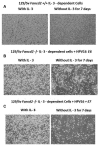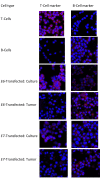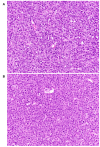Malignant Transformation of Fanconi Anemia Complementation Group D2-deficient (Fancd2 -/-) Hematopoietic Progenitor Cells by a Single HPV16 Oncogene
- PMID: 30804107
- PMCID: PMC6506306
- DOI: 10.21873/invivo.11476
Malignant Transformation of Fanconi Anemia Complementation Group D2-deficient (Fancd2 -/-) Hematopoietic Progenitor Cells by a Single HPV16 Oncogene
Abstract
Aim: To demonstrate that Fanconi anemia complementation group D2-deficient (Fancd2-/-) hematopoietic progenitor cell lines can be transformed by transfection with a plasmid containing either the E6 or E7 oncogene of human papillomavirus (HPV) to generate malignant plasmacytoma-inducing cell lines.
Materials and methods: In order to determine whether a single HPV type 16 (HPV16) oncogene induced malignant transformation, Fancd2-/- and Fancd2+/+ interleukin 3 (IL3)-dependent hematopoietic progenitor cell lines were transfected with plasmids containing E6 or E7 oncogene, or control empty plasmid.
Results: Fancd2-/- but not Fancd2+/+ cells were transformed into malignant IL3-independent cells by both E6, and E7 oncogenes, but not by empty plasmid. Hematopoietic cell lines and tumors induced by Fancd2-/- E6 and Fancd2-/- E7 cell lines were positive for each respective HPV RNA and protein.
Conclusion: A single HPV16 oncogene is adequate to produce malignant transformation of Fancd2-/- hematopoietic cells.
Keywords: E6 and E7 oncogene; Fanconi anemia; Human Papillomavirus.
Copyright© 2019, International Institute of Anticancer Research (Dr. George J. Delinasios), All rights reserved.
Conflict of interest statement
Drs. Greenberger and Epperly have a conflict of interest due to the issuance of patents for JP4-039 and related compounds, as radiation protectors and mitigators.
Figures








Similar articles
-
Evolution of malignant plasmacytoma cell lines from K14E7 Fancd2-/- mouse long-term bone marrow cultures.Oncotarget. 2016 Oct 18;7(42):68449-68472. doi: 10.18632/oncotarget.12036. Oncotarget. 2016. PMID: 27637088 Free PMC article.
-
High-risk human papillomavirus oncogenes disrupt the Fanconi anemia DNA repair pathway by impairing localization and de-ubiquitination of FancD2.PLoS Pathog. 2019 Feb 28;15(2):e1007442. doi: 10.1371/journal.ppat.1007442. eCollection 2019 Feb. PLoS Pathog. 2019. PMID: 30818369 Free PMC article.
-
Activation of Wnt signaling pathway by human papillomavirus E6 and E7 oncogenes in HPV16-positive oropharyngeal squamous carcinoma cells.Mol Cancer Res. 2010 Mar;8(3):433-43. doi: 10.1158/1541-7786.MCR-09-0345. Epub 2010 Mar 9. Mol Cancer Res. 2010. PMID: 20215420
-
HPV DNA, E6/E7 mRNA, and p16INK4a detection in head and neck cancers: a systematic review and meta-analysis.Lancet Oncol. 2014 Nov;15(12):1319-31. doi: 10.1016/S1470-2045(14)70471-1. Epub 2014 Oct 16. Lancet Oncol. 2014. PMID: 25439690
-
Mechanisms in the transformation of IL3-dependent hematopoietic stem cells.Curr Top Microbiol Immunol. 1989;149:59-69. doi: 10.1007/978-3-642-74623-9_5. Curr Top Microbiol Immunol. 1989. PMID: 2499442 Review. No abstract available.
Cited by
-
Radioresistance of Serpinb3a-/- Mice and Derived Hematopoietic and Marrow Stromal Cell Lines.Radiat Res. 2019 Sep;192(3):267-281. doi: 10.1667/RR15379.1. Epub 2019 Jul 11. Radiat Res. 2019. PMID: 31295086 Free PMC article.
References
-
- Berhane H, Epperly MW, Goff J, Kalash R, Cao S, Franicola D, Zhang X, Shields D, Houghton F, Wang H, Sprachman M, Wipf P, Parmar K, Greenberger JS. Radiobiologic differences between bone marrow stromal and hematopoietic progenitor cell lines from Fanconi anemia (Fancd2−/−) mice. Radiat Res. 2014;181:76–89. - PMC - PubMed
-
- Berhane H, Shinde A, Kalash R, Xu K, Epperly MW, Goff J, Franicola D, Zhang X, Dixon T, Shields D, Wang H, Wipf P, Li S, Gao X, Greenberger JS. Amelioration of irradiation-induced oral cavity mucositis and distant bone marrow suppression in Fancd2−/− (FVB/N) mice by intraoral JP4-039/F15. Radiat Res. 2014;182:35–49. - PMC - PubMed
MeSH terms
Substances
Grants and funding
LinkOut - more resources
Full Text Sources
Medical
Miscellaneous
